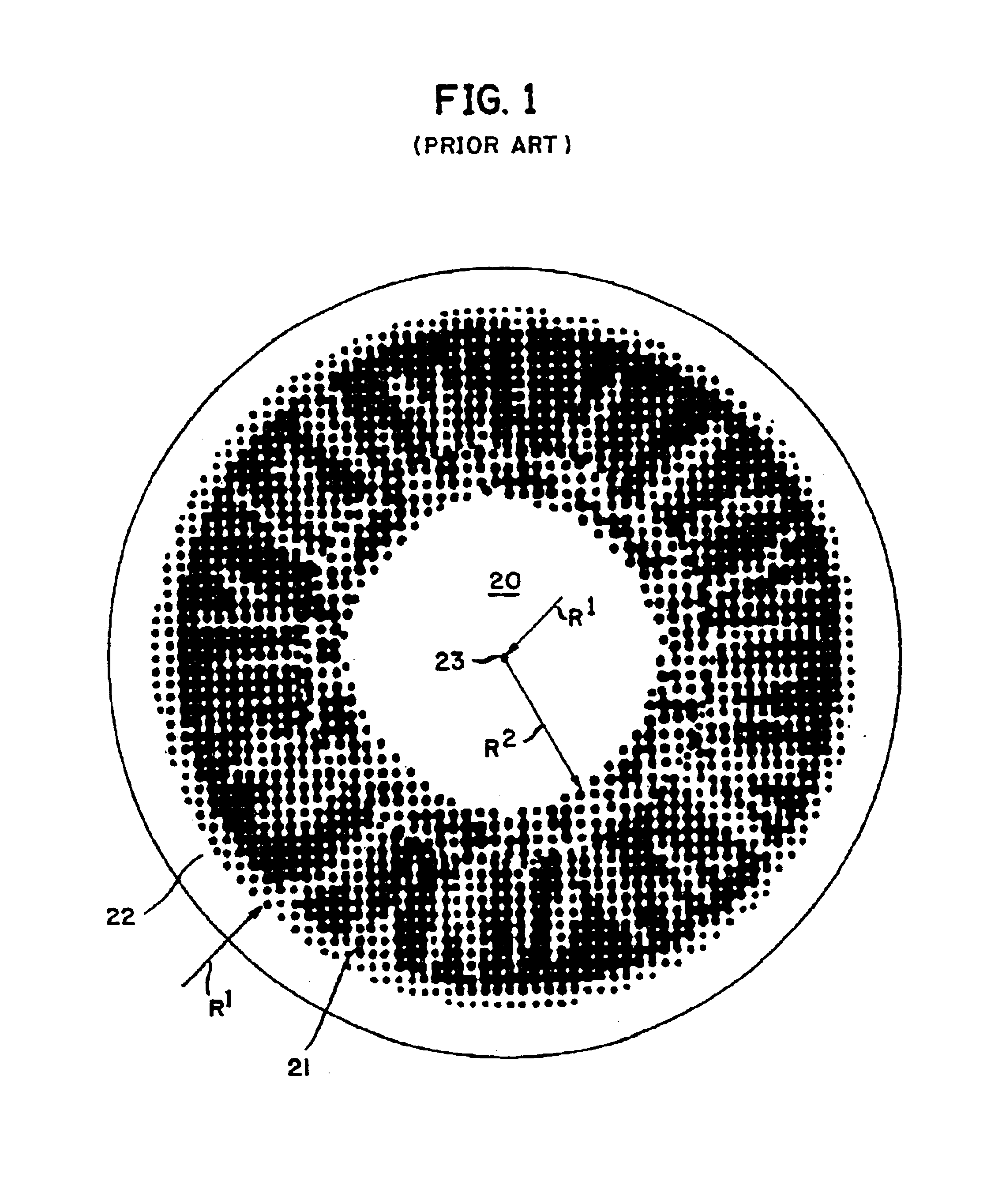Colored contact lens having very natural appearance
a contact lens and very natural technology, applied in the field of colored contact lenses, can solve the problems of lens never achieving commercial success, unnatural appearance of lens,
- Summary
- Abstract
- Description
- Claims
- Application Information
AI Technical Summary
Benefits of technology
Problems solved by technology
Method used
Image
Examples
example 1
[0035]A hydrophilic lens made of hydroxyethyl methacrylate, ethoxy ethyl methacrylate, and methacrylic acid as shown in U.S. Pat. No. 4,668,240 is printed on its front, convex side with ink of a first shade containing pigment, binding polymer made from the same monomers used to form the lens, hexamethylene diisocyanate and solvent. The printed pattern is shown in FIG. 1. It covers most of the iris section, having an annular form, with an outer radius R1 of about 5.2 mm and an inner radius R2 of about 2.2 mm. After the ink has cured, the first pattern is overprinted with the pattern shown in FIG. 2 having a different shade than the pattern of FIG. 1. To accomplish this second printing, it is highly preferable to have the centers 23 of the patterns overlap. However, it is not necessary to rotationally align the patterns of FIGS. 1 and 2. That is, after the FIG. 1 pattern is printed on the lens, the rotation of the lens or the pad used in printing the pattern of FIG. 2 about lens cente...
example 2
[0042]A contact lens is printed first with the pattern of FIG. 3 and then with the pattern of FIG. 2 in a second shade. When using these two patterns, centers 23 of both patterns are in alignment and in addition the patterns are rotationally aligned so that radial lines RL1 and RL2 coincide. The following color combinations are currently preferred:
[0043]
EXAMPLEFIG. 3 PATTERNFIG. 2 PATTERN2AInk No. 1 (Blue)Ink No. 2 (Hazel)2BInk No. 3 (Green)Ink No. 2 (Hazel)2CInk No. 4 (Brown)Ink No. 5 (Yellow Brown)2DInk No. 1 (Blue)Ink No. 6 (Misty Gray)2EInk No. 6 (Misty Gray)Ink No. 7 (Dark Gray)
example 3
[0044]Contact lenses are printed with the pattern of FIG. 4, then with the pattern of FIG. 5 in a second shade, and finally with the pattern of FIG. 6 in a third shade. Centers 23 of each pattern are aligned and patterns 4 and 5 are rotationally aligned along radial lines RL3 and RL4. As seen in FIGS. 4 and 5, the jagged border between the portions of the iris sections having the first and second shades will be a minimum distance of about 10% of the radial width of the iris section from the outer perimeter of the iris section and a maximum distance of about 80% of the radial width. This border is very jagged and less distinct than the border of examples 1 and 2. The following color combinations are currently preferred:
[0045]
EXAMPLEPATTERNFIG. 5 PATTERNPATTERN3AInk No. 3Ink No. 2Ink No. 8(Green)(Hazel)(Black)3BInk No. 1Ink No. 2Ink No. 8(Blue)(Hazel)(Black)3CInk No. 5Ink No. 5Ink No. 8(Brown)(Yellow Brown)(Black)3DInk No. 1Ink No. 6Ink No. 8(Blue)(Gray)(Black)3EInk No. 6Ink No. 7Ink ...
PUM
| Property | Measurement | Unit |
|---|---|---|
| inner radius R2 | aaaaa | aaaaa |
| inner radius R2 | aaaaa | aaaaa |
| outer radius | aaaaa | aaaaa |
Abstract
Description
Claims
Application Information
 Login to View More
Login to View More - R&D
- Intellectual Property
- Life Sciences
- Materials
- Tech Scout
- Unparalleled Data Quality
- Higher Quality Content
- 60% Fewer Hallucinations
Browse by: Latest US Patents, China's latest patents, Technical Efficacy Thesaurus, Application Domain, Technology Topic, Popular Technical Reports.
© 2025 PatSnap. All rights reserved.Legal|Privacy policy|Modern Slavery Act Transparency Statement|Sitemap|About US| Contact US: help@patsnap.com



